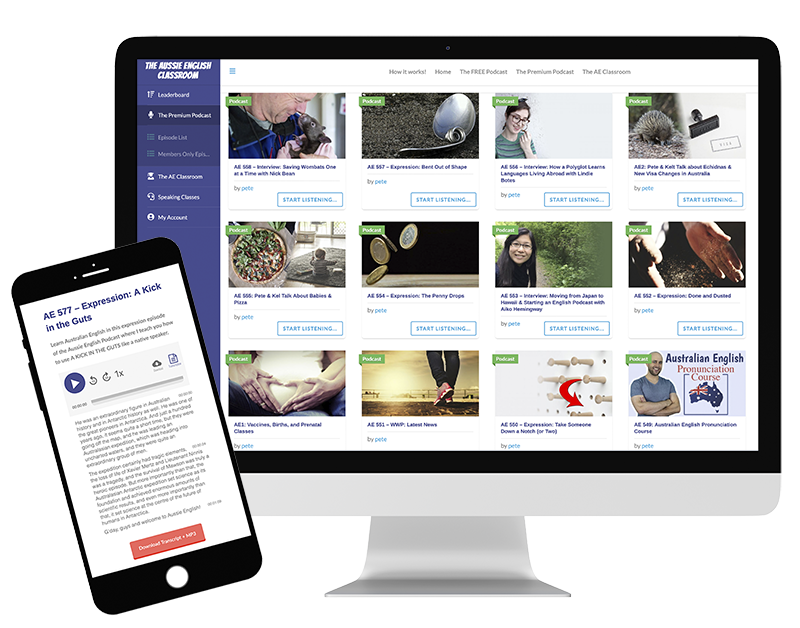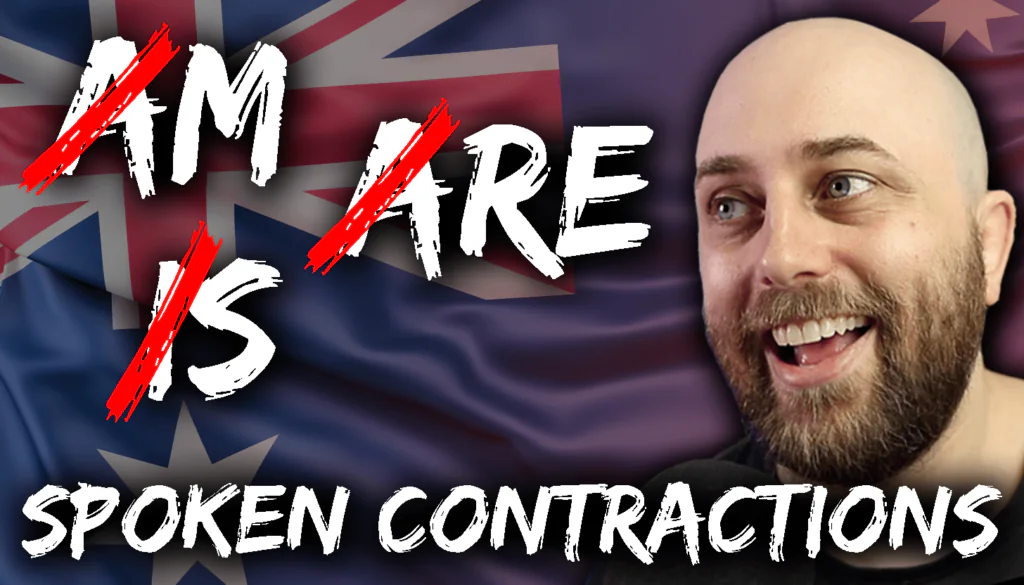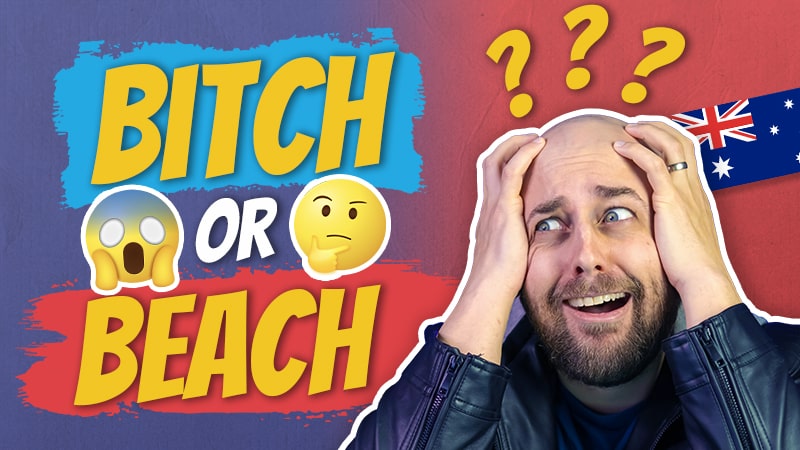AE 545: Linking VOWEL SOUNDS with W or Y or R?
Learn Australian English pronunciation in this video/podcast episode of Aussie English where I teach you how to link two vowel sounds with W, Y, or R.
AE 545: SPEAK Like an AUSTRALIAN: Linking VOWEL SOUNDS with W or Y or R?
G’day, guys! How’s it going?
My name is Pete and I’m the host of The Aussie English podcast and today I am going to teach you how vowels link to other vowels. There are three different rules, guys! They’re pretty simple once broken down and they’re going to make you sound a lot more like a native speaker of English. Ok, let’s go.
Alright so, English, as it is spoken by native speakers, is a language where we like to link all these words together, right? We don’t like saying every single word separately, we like linking the words together and there are a few subtle sounds that we use when smoothly linking different sounds together depending on the types of sounds and the order in which they’re said. They can be linked together in a number of different ways.
Today we’re going to focus on linking two vowels together whether they are within a word or whether they are at the end of one word and the start of another word and we’re going to be doing this focusing on, obviously, the Australian English accent.
So, as I just said guys, vowel and then vowel sequences, you know, where you have one and then the other, these can occur within words, for example: create, but they can also occur between words where you have a vowel sound at the end of one word and a vowel sound at the start of another, for example:
He ate. In Australian English pronunciation we have three different ways that we can link vowels to other vowels ok? And they are the /y/ sound, the /w/ sound and the /r/ sound, which ones do we use this? Depends on the first vowel.
The easy bit ok, the easy bit is that many words whether these two vowels are occurring within the word or whether you have the first vowel at the end of the word, many words show you which linking sound you need to use, where they already end with the letter for that linking sound, for example:
Rear ends with an R, play ends with a Y, bow ends with a W. However, don’t just rely on the spelling in English, as I am sure you are very much aware, the spelling in English often does not reflect the pronunciation of the word that is spelt that way, right?
So, for example: Low rhymes with Faux and Dough.
Day rhymes with Cafe and Weigh.
My rhymes with Thigh and Thai.
And For rhymes with Law and Corps.
So, you can see spelling can help, but it can also be a hindrance sometimes so you just need to practice the sounds and know what those sounds are when you say a word, even if it has shitty spelling.
Alright, so let’s go through the three different linking sounds when we have a vowel followed by another vowel. So, as I stated, which sound you use depends on the sound of the first vowel and the subsequent shape of the mouth after that vowel.
Number one:
The /y/ sound, the /y/ sound is used to link two. Vowels when the first vowel has left the lips wide and the tongue high in the position of the mouth so for vowels such as:
i
aei
ae
oi
Now let me just add that little Y sound on the end and emphasise these.
iy
aeiy
aey
oiy
So, for example:
He‿y‿ate the food
He‿y‿ate the food
Play‿y‿outside kids
Play‿y‿outside kids
I lie‿y‿a lot
I lie‿y‿a lot
Enjoy‿y‿it
Enjoy‿y‿it
You’ll notice that I’m emphasising it first and then I’m showing you how I would say this a little more subtly when I speak naturally ok?
Number two: the linking /w/ sound. So, the linking /w/ is used when the vowel sound, that first vowel sound, has ended with the lips
Contracted so they’re in the shape of and obviously they can’t contract anymore. They have to retract and so you end up with a /w/ sound so, the /w/ sound follows the vowels:
ʉː
əʉ
æɔ
As you can see they all end with the lips very round. So, I’ll just do that again and I’m going to emphasise the w /w/ sound at the ends of each of those vowels, ok?
ʉːw
əʉw
æɔw
So, just retract the lips to get that /w/ sound. Alright, so for example:
It blew‿w‿up
It blew‿w‿up
Ciao‿w‿everyone
Ciao‿w‿everyone
Low‿w‿and lazy
Low‿w‿and lazy
Alright! Number three now. This is a two-for-one. This is a two-for-one.
We have the linking R and we have the intrusive R. Why do we have these in Australian English? And if you’ve learned American English, you may not see these so Australian English is a dialect of English that is
Non-rhotic meaning that we do not pronounce the R sound unless the R is followed by a vowel sound whether within a word or whether the R is at the end of the word and the next word starts with a vowel sound. So, for example:
Red
Orange
Wore‿r‿it
Her‿r‿offer
The R is not said its left silent if the R is followed by a consonant or by no sound at all, for instance:
Word
Car
Wore down
Her school
This is a big thing. If you are wanting to replicate an Australian accent because we just won’t say that R, ok? So, if you’re an American or if you are a
foreign English language learner, ignore the Rs if they are not followed by a vowel. Ok? They generally just make the vowel sound long
The linking R is used when it’s at the end of a word or at the end of a syllable and the next syllable or the next word activates it because that word starts with a vowel sound. So, for example: wore it
Her‿r‿offer
The barber‿r‿asked
Click the link above and you will be able to check out my video on the linking R
Now let’s talk about the intrusive R. So, the intrusive R is used when we insert that between two vowel sounds despite the spelling of the first word not including an R in that word. It’s the vowel sound, guys. It’s the sound of the vowel that matters, remember, not the spelling. So, for instance
Law‿r‿and order
Australia‿r‿is big
Again, click above, guys, and you will see the video that goes into depth on the intrusive R.
Ok, so we use an R sound, whether it’s the intrusive R or linking R, with the following vowel sounds.
So, for example:
The bar‿r‿is open.
The bar‿r‿is open.
Cuba‿r‿is a country.
Cuba‿r‿is a country.
Blur‿r‿everything.
Blur‿r‿everything.
Draw‿r‿it bigger
Draw‿r‿it bigger.
The pier‿r‿is long.
The pier‿r‿is long.
A pair‿r‿of cats.
A pair‿r‿of cats.
Insure‿r‿it.
Insure‿r‿it.
Alright, good job! That wasn’t easy, it comes with time, but now the important bit, how can you guys learn how to do these intuitively, spontaneously, subconsciously like a native speaker of English? So, what do you think the trick is? The trick is there’s no trick!
Repetition, repetition, repetition, guys! In order to learn anything intuitively, you have to do it again, again again and you have to do it in a way where you can slowly learn these rules. You’re not just guessing and then eventually it just becomes spontaneous kind of like grammar, right?
You don’t think about that anymore at least at this level for the present tense,
You’re not going to think “do I need to conjugate in the present tense?” You just do it, right? So, you need to learn to make these sounds intuitively, you want to do it naturally, you want to do it spontaneously like a native speaker.
I will give you somewhere to go where you can do a bunch of exercises after this quiz ok? So, I’m going to read out ten different phrases and I want you to listen and see if you can hear is it a /y/ a /w/ or a /r/ sound that is linking the two vowels in these sentences? Ok, let’s go!
Go away!
Go‿w‿away!
The elephant.
The‿y‿elephant.
Throw it out!
Throw‿w‿It out!
They all came.
They‿y‿all came.
Draw it for me.
Draw‿r‿it for me.
Lie on the bed.
Lie‿y‿on the bed.
Grow up, James!
Grow‿w‿up, James!
The puma is mine.
The puma‿r‿is mine.
Where are you going?
Where‿r‿are you going?
There’s no other option.
There’s no‿w‿other‿r‿option.
Amazing job, guys! Amazing job!
I hope you did well on that quiz now that you have learned these three different rules for how to link a vowel and another vowel in spoken English. Once again, guys, please do not just try to memorise these rules you don’t want to just rely on your memory when speaking spontaneously like this you just don’t have time to remember every time you need to link two words with two vowel sounds, ok?
So, what do you need to do? Alright, so here’s the deal if you want to learn to use these subconsciously, spontaneously and naturally like a native speaker,, make sure that you sign up to The Aussie English Classroom, I have a spoken English course in there where I take you through dozens of different exercises to help you improve your spoken English and most importantly I take you through
exercises for all of the different sounds that you heard today in today’s video
So, join up now guys, there is a link below and you will be able to sign up to your 30-day trial and you will also get access to my 50 other advanced English courses you can access all of them, aside from that, guys, I am Pete the host of the Aussie English Podcast, make sure that you download this podcast if you are trying to get to an advanced level in English. It is free via any good podcast
application, you can use it on your phone, anywhere, anytime and aside from that, thank you so much for joining me and I hope to see you in the next video. Peace out!
Here's what you get when you sign up!
- Read while you listen using the Premium Podcast player.
- Understand every word in every episode.
- Download all PDF transcripts and MP3s for 600+ episodes.
- Get access to bonus member-only episodes.












Responses